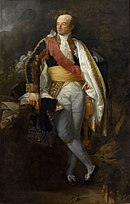Siege of Roses (1794–1795)
| Siege of Roses 1794–1795 | |||||||
|---|---|---|---|---|---|---|---|
| Part of the War of the Pyrenees | |||||||
 Citadel of Roses: Sea Gate | |||||||
| |||||||
| Belligerents | |||||||
|
France |
Spain | ||||||
| Commanders and leaders | |||||||
|
Pierre Sauret |
| ||||||
| Strength | |||||||
| 13,261 | 4,800 | ||||||
| Casualties and losses | |||||||
| light |
583 casualties 1,160 sick | ||||||
The siege of Roses (or siege of Rosas) began on 28 November 1794 and lasted until 4 February 1795 when the
The French inflicted a severe defeat on the Spanish army at
Background
On 17 November 1794, the French
Siege
Forces
The defenses of Roses consisted of a
On 28 November the French invested Roses with 13,261 soldiers. While Sauret had immediate command over the besiegers, Pérignon remained the driving force in prosecuting the siege. Six brigades were subordinated to Sauret for the operation. The brigades were commanded by
Action

On 29 November, the first battery opened fire on the fortress and the French began digging siege trenches. By 7 December, six batteries were pounding the defenses. Izquierdo launched several ineffectual sorties at the French as their siege parallels drew closer to the citadel. By this time Pérignon realized that the Castillo de la Trinidad, whose fire caused serious damage to the besiegers, was the key position. He ordered that heavy guns be installed on Mont Puy-Bois. When the French engineers protested that it could not be done, the commanding general overrode their objections. The French soldiers, whose nickname for the Castillo was le Bouton de Rose (the Pimple), managed to haul three batteries to the summit by 25 December. The batteries on Mont Puy-Bois finally breached the walls of the Castillo and its garrison was taken off in boats on 1 January. From the newly captured position, the French opened fire on the citadel and the fleet.[5]
Meanwhile, the army of Lieutenant General José de Urrutia y de las Casas held a position behind the Rio Fluvià to the south of Roses, threatening to advance to its relief. By 25 January, when wintry weather compelled Sauret to suspend siege operations, Urrutia's army had grown menacingly large. Determined to take the fortress, Pérignon decided to try bluff again. He stormed the Spanish advanced positions on 1 February. The French army commander staged obvious preparations for a full-scale assault, such as the display of scaling ladders in the trenches. This finally broke the morale of the defenders. Izquierdo ordered the surviving members of the garrison to be evacuated by Gravina's squadron on the night of 3 February, leaving a 300-man rear guard behind to cover the operation. The rear guard was supposed to be taken off in small boats in the morning, but they were abandoned by the fleet and became French prisoners.[9]
Results
The Spanish reported 113 killed, 470 wounded, and 1,160 sick during the siege. In addition, 300 soldiers fell into French hands. French losses are unknown but were claimed to be light.[6] Annoyed that Pérignon was unable to advance beyond the Fluvià, the French government replaced him at the end of May 1795 with General of Division Barthélemy Louis Joseph Schérer. Urrutia defeated Schérer at the Battle of Bascara on 14 June. French losses numbered 2,500 while the Spanish army only lost 546 casualties.[10]
The Peace of Basel on 22 July 1795 officially ended the fighting. Spanish forces under Lieutenant General Gregorio García de la Cuesta won two minor actions at Puigcerdà and Bellver de Cerdanya in late July, before news of the peace reached the front.[11] The Second Treaty of San Ildefonso, in which Pérignon played a key role, followed on 19 August 1796. By this pact, Spain became an ally of France.[12]
A subsequent siege of Roses happened in November and December 1808, during the Peninsular War.[13] Previous sieges occurred in 1645 and 1693.[3]
Footnotes
- ^ Ostermann-Chandler (1987), 408
- ^ Smith (1998), 96
- ^ a b Goode (2010), Roses
- ^ Ostermann-Chandler (1987), 415 map
- ^ a b Ostermann-Chandler (1987), 413
- ^ a b Smith (1998), 102
- ^ Prats (2007), Le Bluff. Prats placed Abel Joseph Guillot in Sauret's division.
- ^ Mullié, Guillot. This source stated that François Gilles Guillot served in the Eastern Pyrenees and was wounded on 20 November 1794 (that is, at the Battle of the Black Mountain).
- ^ Ostermann-Chandler (1987), 413–414
- ^ Smith (1998), 103
- ^ Smith (1998), 104
- ^ Ostermann-Chandler (1987), 409
- ^ Smith (1998), 271–272
References
- Goode, Dominic (2010). "Fortresses". fortified-places.com. Retrieved 1 June 2012.
- Ostermann, Georges (1987). "Pérignon: The Unknown Marshal". In ISBN 0-02-905930-5.
- Mullié, Charles (1852). Biographie des célébrités militaires des armées de terre et de mer de 1789 a 1850 (in French). Paris.
{{cite book}}: CS1 maint: location missing publisher (link) - Prats, Bernard (2007). "1793–1795 La Convention contre L'Espagne: Le bluff de Dominique Perignon depasse la realite de l'histoire" (in French).
- ISBN 1-85367-276-9.
External links
The following reference is an excellent source for the full names of French generals.
- Broughton, Tony. "Generals Who Served in the French Army during the Period 1789–1815". The Napoleon Series. Retrieved 7 April 2012.
